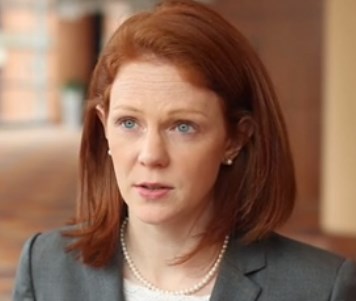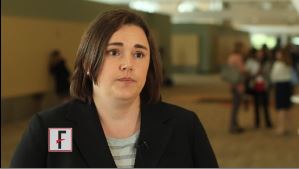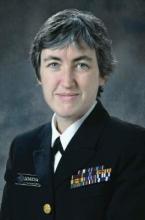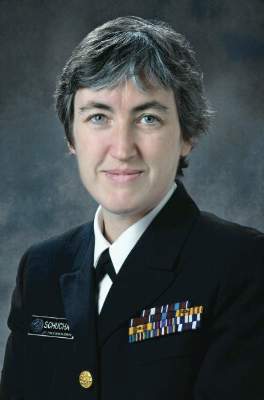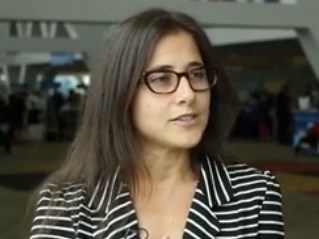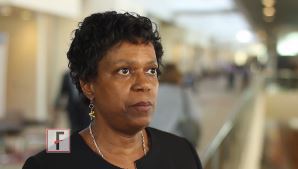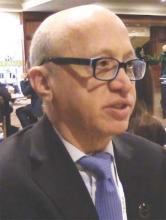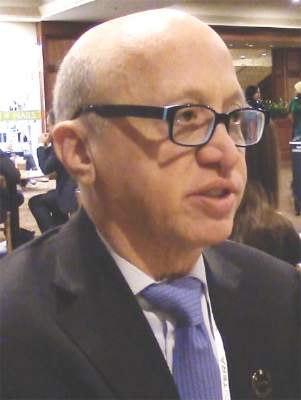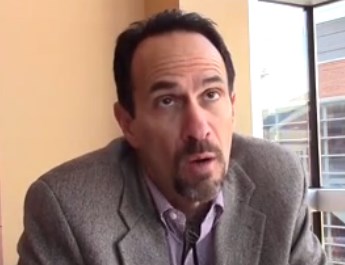User login
Infantile hemangiomas clear faster with Nd:YAG treatment
BOSTON – Using a 650-microsecond, pulsed 1064nm neodymium-doped yttrium aluminum garnet (Nd:YAG) laser to treat infantile hemangiomas can yield high clearance rates after one treatment, without adverse reactions, according to a study presented at the annual meeting of the American Society for Laser Medicine and Surgery.
“[Hemangiomas] have historically been treated with a bunch of different devices; most commonly, the pulsed dye laser and also propranolol, either orally or topically,” said Dr. David J. Goldberg of Skin Laser & Surgery Specialists of New York and New Jersey. While use of an Nd:YAG laser for treating infantile hemangiomas is not exactly new, “what’s new about this is it was not a millisecond Nd:YAG laser; it was a microsecond Nd:YAG laser, [which] generally makes it much safer for treatment in general.”
The study enrolled 250 children between age 1 month and 4 months at the time of recruitment; they were followed for one year. They received a single treatment with an Nd:YAG 1064nm laser using a 650 microsecond pulse duration, a spot size of 2-3 millimeters, and a fluence of 42-64 joules per square centimeter. Photographs were taken for evaluation immediately before and after each treatment, and 30 and 180 days after each treatment.
Treatments lasted 3-5 minutes each, covering an area no larger than three square centimeters. Infants who started treatment in the first six weeks of life had the best results, according to Dr. Goldberg. Treated areas immediately turned gray after each treatment on all subjects, and all subjects showed “substantial improvement” in hemangioma size after only a single treatment, based on photographic evaluation taken 6 months after treatment. Over 75% of hemangiomas were either completely or almost completely (over 75% clearance) eliminated over the 1-year follow-up period.
There was no downtime or adverse events experienced by any patients following treatments. Overall, parents of the children who received treatment were “highly satisfied” with the results.
“The big takeaway is that you may not need multiple treatments [and] you may not need to use a pulse dye laser – one treatment may be enough,” Dr. Goldberg explained. “This [Nd:YAG] device is also a very small device that you can put into a suitcase, so it’s not that big device that we’re used to using.”
Dr. Goldberg did not report any relevant financial disclosures.
BOSTON – Using a 650-microsecond, pulsed 1064nm neodymium-doped yttrium aluminum garnet (Nd:YAG) laser to treat infantile hemangiomas can yield high clearance rates after one treatment, without adverse reactions, according to a study presented at the annual meeting of the American Society for Laser Medicine and Surgery.
“[Hemangiomas] have historically been treated with a bunch of different devices; most commonly, the pulsed dye laser and also propranolol, either orally or topically,” said Dr. David J. Goldberg of Skin Laser & Surgery Specialists of New York and New Jersey. While use of an Nd:YAG laser for treating infantile hemangiomas is not exactly new, “what’s new about this is it was not a millisecond Nd:YAG laser; it was a microsecond Nd:YAG laser, [which] generally makes it much safer for treatment in general.”
The study enrolled 250 children between age 1 month and 4 months at the time of recruitment; they were followed for one year. They received a single treatment with an Nd:YAG 1064nm laser using a 650 microsecond pulse duration, a spot size of 2-3 millimeters, and a fluence of 42-64 joules per square centimeter. Photographs were taken for evaluation immediately before and after each treatment, and 30 and 180 days after each treatment.
Treatments lasted 3-5 minutes each, covering an area no larger than three square centimeters. Infants who started treatment in the first six weeks of life had the best results, according to Dr. Goldberg. Treated areas immediately turned gray after each treatment on all subjects, and all subjects showed “substantial improvement” in hemangioma size after only a single treatment, based on photographic evaluation taken 6 months after treatment. Over 75% of hemangiomas were either completely or almost completely (over 75% clearance) eliminated over the 1-year follow-up period.
There was no downtime or adverse events experienced by any patients following treatments. Overall, parents of the children who received treatment were “highly satisfied” with the results.
“The big takeaway is that you may not need multiple treatments [and] you may not need to use a pulse dye laser – one treatment may be enough,” Dr. Goldberg explained. “This [Nd:YAG] device is also a very small device that you can put into a suitcase, so it’s not that big device that we’re used to using.”
Dr. Goldberg did not report any relevant financial disclosures.
BOSTON – Using a 650-microsecond, pulsed 1064nm neodymium-doped yttrium aluminum garnet (Nd:YAG) laser to treat infantile hemangiomas can yield high clearance rates after one treatment, without adverse reactions, according to a study presented at the annual meeting of the American Society for Laser Medicine and Surgery.
“[Hemangiomas] have historically been treated with a bunch of different devices; most commonly, the pulsed dye laser and also propranolol, either orally or topically,” said Dr. David J. Goldberg of Skin Laser & Surgery Specialists of New York and New Jersey. While use of an Nd:YAG laser for treating infantile hemangiomas is not exactly new, “what’s new about this is it was not a millisecond Nd:YAG laser; it was a microsecond Nd:YAG laser, [which] generally makes it much safer for treatment in general.”
The study enrolled 250 children between age 1 month and 4 months at the time of recruitment; they were followed for one year. They received a single treatment with an Nd:YAG 1064nm laser using a 650 microsecond pulse duration, a spot size of 2-3 millimeters, and a fluence of 42-64 joules per square centimeter. Photographs were taken for evaluation immediately before and after each treatment, and 30 and 180 days after each treatment.
Treatments lasted 3-5 minutes each, covering an area no larger than three square centimeters. Infants who started treatment in the first six weeks of life had the best results, according to Dr. Goldberg. Treated areas immediately turned gray after each treatment on all subjects, and all subjects showed “substantial improvement” in hemangioma size after only a single treatment, based on photographic evaluation taken 6 months after treatment. Over 75% of hemangiomas were either completely or almost completely (over 75% clearance) eliminated over the 1-year follow-up period.
There was no downtime or adverse events experienced by any patients following treatments. Overall, parents of the children who received treatment were “highly satisfied” with the results.
“The big takeaway is that you may not need multiple treatments [and] you may not need to use a pulse dye laser – one treatment may be enough,” Dr. Goldberg explained. “This [Nd:YAG] device is also a very small device that you can put into a suitcase, so it’s not that big device that we’re used to using.”
Dr. Goldberg did not report any relevant financial disclosures.
AT LASER 2016
Key clinical point: Infantile hemangiomas can be effectively treated with a 650-microsecond pulsed Nd:YAG 1064nm laser, with no evidence of adverse skin effects.
Major finding: Substantial improvement in hemangiomas were seen after one treatment administered in 5 minutes or less.
Data source: The study enrolled 250 infants with hemangiomas aged 1 to 4 months at baseline, and were followed for one year.
Disclosures: Dr. Goldberg did not report any relevant financial disclosures.
Behavioral seminars for parents can improve child’s behavior, decrease corporal punishment
BALTIMORE – Parents who take behavior seminars for dealing with their children, such as one known as Child-Adult Relationship Enhancement (CARE), can significantly improve a child’s behavior and the parent/child relationship while reducing dependence on corporal punishment as a disciplinary tool.
“[CARE] is a group-based parenting program that involves parents coming into six sessions over 6 weeks, and each session is facilitated by two mental health therapists [who] teach parents different positive parenting skills,” explained Dr. Samantha Schilling of the University of North Carolina at Chapel Hill, adding that parents are taught how to “increase or reinforce positive behaviors [through] different techniques, such as what we call the three Ps: praising, paraphrasing, and pointing out good child behavior.”
In an interview at the annual meeting of the Pediatric Academic Societies, Dr. Schilling discussed the importance of implementing CARE programs and, more specifically, colocating such programs in primary care practices.
Dr. Schilling did not report any relevant financial disclosures.
The video associated with this article is no longer available on this site. Please view all of our videos on the MDedge YouTube channel
BALTIMORE – Parents who take behavior seminars for dealing with their children, such as one known as Child-Adult Relationship Enhancement (CARE), can significantly improve a child’s behavior and the parent/child relationship while reducing dependence on corporal punishment as a disciplinary tool.
“[CARE] is a group-based parenting program that involves parents coming into six sessions over 6 weeks, and each session is facilitated by two mental health therapists [who] teach parents different positive parenting skills,” explained Dr. Samantha Schilling of the University of North Carolina at Chapel Hill, adding that parents are taught how to “increase or reinforce positive behaviors [through] different techniques, such as what we call the three Ps: praising, paraphrasing, and pointing out good child behavior.”
In an interview at the annual meeting of the Pediatric Academic Societies, Dr. Schilling discussed the importance of implementing CARE programs and, more specifically, colocating such programs in primary care practices.
Dr. Schilling did not report any relevant financial disclosures.
The video associated with this article is no longer available on this site. Please view all of our videos on the MDedge YouTube channel
BALTIMORE – Parents who take behavior seminars for dealing with their children, such as one known as Child-Adult Relationship Enhancement (CARE), can significantly improve a child’s behavior and the parent/child relationship while reducing dependence on corporal punishment as a disciplinary tool.
“[CARE] is a group-based parenting program that involves parents coming into six sessions over 6 weeks, and each session is facilitated by two mental health therapists [who] teach parents different positive parenting skills,” explained Dr. Samantha Schilling of the University of North Carolina at Chapel Hill, adding that parents are taught how to “increase or reinforce positive behaviors [through] different techniques, such as what we call the three Ps: praising, paraphrasing, and pointing out good child behavior.”
In an interview at the annual meeting of the Pediatric Academic Societies, Dr. Schilling discussed the importance of implementing CARE programs and, more specifically, colocating such programs in primary care practices.
Dr. Schilling did not report any relevant financial disclosures.
The video associated with this article is no longer available on this site. Please view all of our videos on the MDedge YouTube channel
AT THE PAS ANNUAL MEETING
VIDEO: Childhood obesity, particularly severe obesity, is not declining
BALTIMORE – Rates of obesity, particularly severe obesity, in children have not decreased since 1999, despite what recent studies may say, according to a study presented at the annual meeting of the Pediatric Academic Societies.
“Overall, there is no evidence of a decrease in obesity in any of our age groups,” said Asheley C. Skinner, Ph.D., of Duke University in Durham, N.C., adding that “we see a sort of consistent, ongoing increase up through 2014 for severe obesity and regular class I obesity for all of our age groups.”
In a video interview, Dr. Skinner discussed the findings of her study, in which data from the National Health and Nutrition Examination Survey (NHANES) from the years 1999-2014 were examined to determine obesity in children aged 2-19 years. A combination of body mass index (BMI) and “a percentage of the 95th percentile” of weight across three age groups – 2-5 years, 6-11 years, and 12-19 years – was used to classify children with class I, class II, or class III (severe) obesity.
Dr. Skinner did not report any relevant financial disclosures.
The video associated with this article is no longer available on this site. Please view all of our videos on the MDedge YouTube channel
BALTIMORE – Rates of obesity, particularly severe obesity, in children have not decreased since 1999, despite what recent studies may say, according to a study presented at the annual meeting of the Pediatric Academic Societies.
“Overall, there is no evidence of a decrease in obesity in any of our age groups,” said Asheley C. Skinner, Ph.D., of Duke University in Durham, N.C., adding that “we see a sort of consistent, ongoing increase up through 2014 for severe obesity and regular class I obesity for all of our age groups.”
In a video interview, Dr. Skinner discussed the findings of her study, in which data from the National Health and Nutrition Examination Survey (NHANES) from the years 1999-2014 were examined to determine obesity in children aged 2-19 years. A combination of body mass index (BMI) and “a percentage of the 95th percentile” of weight across three age groups – 2-5 years, 6-11 years, and 12-19 years – was used to classify children with class I, class II, or class III (severe) obesity.
Dr. Skinner did not report any relevant financial disclosures.
The video associated with this article is no longer available on this site. Please view all of our videos on the MDedge YouTube channel
BALTIMORE – Rates of obesity, particularly severe obesity, in children have not decreased since 1999, despite what recent studies may say, according to a study presented at the annual meeting of the Pediatric Academic Societies.
“Overall, there is no evidence of a decrease in obesity in any of our age groups,” said Asheley C. Skinner, Ph.D., of Duke University in Durham, N.C., adding that “we see a sort of consistent, ongoing increase up through 2014 for severe obesity and regular class I obesity for all of our age groups.”
In a video interview, Dr. Skinner discussed the findings of her study, in which data from the National Health and Nutrition Examination Survey (NHANES) from the years 1999-2014 were examined to determine obesity in children aged 2-19 years. A combination of body mass index (BMI) and “a percentage of the 95th percentile” of weight across three age groups – 2-5 years, 6-11 years, and 12-19 years – was used to classify children with class I, class II, or class III (severe) obesity.
Dr. Skinner did not report any relevant financial disclosures.
The video associated with this article is no longer available on this site. Please view all of our videos on the MDedge YouTube channel
AT THE PAS ANNUAL MEETING
Consider behavior therapy first for young children with ADHD
The Centers for Disease Control and Prevention is urging pediatricians treating children with attention-deficit/hyperactivity disorder (ADHD) to recommend behavior therapy before prescribing any ADHD-specific medications.
In its latest Vital Signs report, the CDC highlights the importance of having parents of children with ADHD – specifically, children between the ages of 2 and 5 years – develop critical communication, reinforcement, and disciplinary skills to improve the children’s behavior without the use of any additional medication.
“Behavior therapy has been shown to improve symptoms of children with ADHD and can be as effective as medicine, but without the side effects,” CDC Principal Deputy Director Anne Schuchat explained during a teleconference on May 3.
Behavior therapy involves parents of children with ADHD attending a series of therapist-led sessions designed to teach strategies that will “encourage positive behavior, discourage negative behaviors, improve communication, and strengthen their relationship with their child,” according to the CDC. The number of sessions is typically eight, although that number often can run higher.
“This kind of therapy … strengthens the relationship between the parent and child, and it gives parents more effective tools to help their child learn positive behaviors,” said Dr. Georgina Peacock, director of the division of human development and disability at the CDC’s National Center on Birth Defects and Developmental Disabilities.
There are three key takeaways from behavior therapy: positive communication, or giving children your full attention and using the same words with them that they use with you to show that you’re listening; positive reinforcement, or praising your child when he or she does something well to incentivize similar behavior in the future; and structure, or setting up daily routines so that children know what to expect and everyday life becomes predictable for them. Parents who have undergone behavior therapy have reported that their children perform better in school, behave better at home, and improve interpersonal relationships, according to Dr. Peacock.
“Sometimes a therapist works directly with a parent and child; other times, the therapist meets with just the parents,” she clarified. “Parents will go home and practice techniques, and then go back to the therapist to talk about what worked and what didn’t, and what new skills to practice again.”
According to the CDC, only 15% of young children with ADHD are receiving only psychological services, compared with an overwhelming 49% who are receiving only medication and 27% who are receiving medication and psychological services. Nine percent of children aged 2-5 years with ADHD are not receiving either form of care.
Data from 2011 and 2012 show that 6.4 million U.S. children aged 4-17 years have ADHD, with about 2 million of them diagnosed before the age of 6 years. Childhood ADHD has been linked to higher rates of emergency department visits, unintentional injuries, high school dropouts, and grade level retention.
““The bottom line is that we know parents want to do what’s best for their children, and we want to help,” said Dr. Schuchat, adding that “we know that medicine can be appropriate for some young children, but we encourage pediatricians, therapists, and other health care providers to work with families to make sure that children with ADHD are receiving the most appropriate treatment.”
The Centers for Disease Control and Prevention is urging pediatricians treating children with attention-deficit/hyperactivity disorder (ADHD) to recommend behavior therapy before prescribing any ADHD-specific medications.
In its latest Vital Signs report, the CDC highlights the importance of having parents of children with ADHD – specifically, children between the ages of 2 and 5 years – develop critical communication, reinforcement, and disciplinary skills to improve the children’s behavior without the use of any additional medication.
“Behavior therapy has been shown to improve symptoms of children with ADHD and can be as effective as medicine, but without the side effects,” CDC Principal Deputy Director Anne Schuchat explained during a teleconference on May 3.
Behavior therapy involves parents of children with ADHD attending a series of therapist-led sessions designed to teach strategies that will “encourage positive behavior, discourage negative behaviors, improve communication, and strengthen their relationship with their child,” according to the CDC. The number of sessions is typically eight, although that number often can run higher.
“This kind of therapy … strengthens the relationship between the parent and child, and it gives parents more effective tools to help their child learn positive behaviors,” said Dr. Georgina Peacock, director of the division of human development and disability at the CDC’s National Center on Birth Defects and Developmental Disabilities.
There are three key takeaways from behavior therapy: positive communication, or giving children your full attention and using the same words with them that they use with you to show that you’re listening; positive reinforcement, or praising your child when he or she does something well to incentivize similar behavior in the future; and structure, or setting up daily routines so that children know what to expect and everyday life becomes predictable for them. Parents who have undergone behavior therapy have reported that their children perform better in school, behave better at home, and improve interpersonal relationships, according to Dr. Peacock.
“Sometimes a therapist works directly with a parent and child; other times, the therapist meets with just the parents,” she clarified. “Parents will go home and practice techniques, and then go back to the therapist to talk about what worked and what didn’t, and what new skills to practice again.”
According to the CDC, only 15% of young children with ADHD are receiving only psychological services, compared with an overwhelming 49% who are receiving only medication and 27% who are receiving medication and psychological services. Nine percent of children aged 2-5 years with ADHD are not receiving either form of care.
Data from 2011 and 2012 show that 6.4 million U.S. children aged 4-17 years have ADHD, with about 2 million of them diagnosed before the age of 6 years. Childhood ADHD has been linked to higher rates of emergency department visits, unintentional injuries, high school dropouts, and grade level retention.
““The bottom line is that we know parents want to do what’s best for their children, and we want to help,” said Dr. Schuchat, adding that “we know that medicine can be appropriate for some young children, but we encourage pediatricians, therapists, and other health care providers to work with families to make sure that children with ADHD are receiving the most appropriate treatment.”
The Centers for Disease Control and Prevention is urging pediatricians treating children with attention-deficit/hyperactivity disorder (ADHD) to recommend behavior therapy before prescribing any ADHD-specific medications.
In its latest Vital Signs report, the CDC highlights the importance of having parents of children with ADHD – specifically, children between the ages of 2 and 5 years – develop critical communication, reinforcement, and disciplinary skills to improve the children’s behavior without the use of any additional medication.
“Behavior therapy has been shown to improve symptoms of children with ADHD and can be as effective as medicine, but without the side effects,” CDC Principal Deputy Director Anne Schuchat explained during a teleconference on May 3.
Behavior therapy involves parents of children with ADHD attending a series of therapist-led sessions designed to teach strategies that will “encourage positive behavior, discourage negative behaviors, improve communication, and strengthen their relationship with their child,” according to the CDC. The number of sessions is typically eight, although that number often can run higher.
“This kind of therapy … strengthens the relationship between the parent and child, and it gives parents more effective tools to help their child learn positive behaviors,” said Dr. Georgina Peacock, director of the division of human development and disability at the CDC’s National Center on Birth Defects and Developmental Disabilities.
There are three key takeaways from behavior therapy: positive communication, or giving children your full attention and using the same words with them that they use with you to show that you’re listening; positive reinforcement, or praising your child when he or she does something well to incentivize similar behavior in the future; and structure, or setting up daily routines so that children know what to expect and everyday life becomes predictable for them. Parents who have undergone behavior therapy have reported that their children perform better in school, behave better at home, and improve interpersonal relationships, according to Dr. Peacock.
“Sometimes a therapist works directly with a parent and child; other times, the therapist meets with just the parents,” she clarified. “Parents will go home and practice techniques, and then go back to the therapist to talk about what worked and what didn’t, and what new skills to practice again.”
According to the CDC, only 15% of young children with ADHD are receiving only psychological services, compared with an overwhelming 49% who are receiving only medication and 27% who are receiving medication and psychological services. Nine percent of children aged 2-5 years with ADHD are not receiving either form of care.
Data from 2011 and 2012 show that 6.4 million U.S. children aged 4-17 years have ADHD, with about 2 million of them diagnosed before the age of 6 years. Childhood ADHD has been linked to higher rates of emergency department visits, unintentional injuries, high school dropouts, and grade level retention.
““The bottom line is that we know parents want to do what’s best for their children, and we want to help,” said Dr. Schuchat, adding that “we know that medicine can be appropriate for some young children, but we encourage pediatricians, therapists, and other health care providers to work with families to make sure that children with ADHD are receiving the most appropriate treatment.”
FROM A CDC TELECONFERENCE
VIDEO: Comanagement effective at treating mental health issues in pediatric patients
BALTIMORE – For pediatric group practices to move toward comanagement to more effectively treat any mental health issues their patients may exhibit, the first step is to educate pediatricians about the benefits of comanagement, according to a study presented at the annual meeting of the Pediatric Academic Societies.
“Pediatricians who had had at least 4 weeks of developmental behavioral pediatrics – or had targeted training on treatment for ADHD, anxiety, depression, behavioral problems – were more likely to comanage at least 50% of their patients” with mental health disorders, explained Dr. Cori Green of Cornell University, New York.
In a video interview, Dr. Green discussed the findings of her study, which consisted of 305 group practices in the 2013 American Academy of Pediatrics Periodic Survey, and the importance of education in teaching residents, trainees, and fellows about comanagement.
Dr. Green did not report any relevant financial disclosures.
The video associated with this article is no longer available on this site. Please view all of our videos on the MDedge YouTube channel
BALTIMORE – For pediatric group practices to move toward comanagement to more effectively treat any mental health issues their patients may exhibit, the first step is to educate pediatricians about the benefits of comanagement, according to a study presented at the annual meeting of the Pediatric Academic Societies.
“Pediatricians who had had at least 4 weeks of developmental behavioral pediatrics – or had targeted training on treatment for ADHD, anxiety, depression, behavioral problems – were more likely to comanage at least 50% of their patients” with mental health disorders, explained Dr. Cori Green of Cornell University, New York.
In a video interview, Dr. Green discussed the findings of her study, which consisted of 305 group practices in the 2013 American Academy of Pediatrics Periodic Survey, and the importance of education in teaching residents, trainees, and fellows about comanagement.
Dr. Green did not report any relevant financial disclosures.
The video associated with this article is no longer available on this site. Please view all of our videos on the MDedge YouTube channel
BALTIMORE – For pediatric group practices to move toward comanagement to more effectively treat any mental health issues their patients may exhibit, the first step is to educate pediatricians about the benefits of comanagement, according to a study presented at the annual meeting of the Pediatric Academic Societies.
“Pediatricians who had had at least 4 weeks of developmental behavioral pediatrics – or had targeted training on treatment for ADHD, anxiety, depression, behavioral problems – were more likely to comanage at least 50% of their patients” with mental health disorders, explained Dr. Cori Green of Cornell University, New York.
In a video interview, Dr. Green discussed the findings of her study, which consisted of 305 group practices in the 2013 American Academy of Pediatrics Periodic Survey, and the importance of education in teaching residents, trainees, and fellows about comanagement.
Dr. Green did not report any relevant financial disclosures.
The video associated with this article is no longer available on this site. Please view all of our videos on the MDedge YouTube channel
AT THE PAS ANNUAL MEETING
Children with internalizing symptoms may not get enough attention
BALTIMORE – Children who exhibit only internalizing symptoms, which are often indicative of anxiety and depression, are less likely to be referred to mental health services than children who exhibit not only the same internalizing behavior, but also external and attentional behavior.
“Pediatricians now are doing much more about mental health; we’ve been energized about how this is an important determinant not only of the child’s present health, but the child’s long-term health, and how they function in the world,” explained Dr. Diane Bloomfield of The Children’s Hospital at Montefiore, Bronx, N.Y., at the annual meeting of the Pediatric Academic Societies.
In a video interview, Dr. Bloomfield discussed the importance of making sure children with internalizing symptoms are referred to the proper specialists, how electronic health records can play a part in children slipping through the cracks, and why educating parents is a critical step in addressing the needs of internalizing children.
Dr. Bloomfield did not report any relevant financial disclosures.
The video associated with this article is no longer available on this site. Please view all of our videos on the MDedge YouTube channel
BALTIMORE – Children who exhibit only internalizing symptoms, which are often indicative of anxiety and depression, are less likely to be referred to mental health services than children who exhibit not only the same internalizing behavior, but also external and attentional behavior.
“Pediatricians now are doing much more about mental health; we’ve been energized about how this is an important determinant not only of the child’s present health, but the child’s long-term health, and how they function in the world,” explained Dr. Diane Bloomfield of The Children’s Hospital at Montefiore, Bronx, N.Y., at the annual meeting of the Pediatric Academic Societies.
In a video interview, Dr. Bloomfield discussed the importance of making sure children with internalizing symptoms are referred to the proper specialists, how electronic health records can play a part in children slipping through the cracks, and why educating parents is a critical step in addressing the needs of internalizing children.
Dr. Bloomfield did not report any relevant financial disclosures.
The video associated with this article is no longer available on this site. Please view all of our videos on the MDedge YouTube channel
BALTIMORE – Children who exhibit only internalizing symptoms, which are often indicative of anxiety and depression, are less likely to be referred to mental health services than children who exhibit not only the same internalizing behavior, but also external and attentional behavior.
“Pediatricians now are doing much more about mental health; we’ve been energized about how this is an important determinant not only of the child’s present health, but the child’s long-term health, and how they function in the world,” explained Dr. Diane Bloomfield of The Children’s Hospital at Montefiore, Bronx, N.Y., at the annual meeting of the Pediatric Academic Societies.
In a video interview, Dr. Bloomfield discussed the importance of making sure children with internalizing symptoms are referred to the proper specialists, how electronic health records can play a part in children slipping through the cracks, and why educating parents is a critical step in addressing the needs of internalizing children.
Dr. Bloomfield did not report any relevant financial disclosures.
The video associated with this article is no longer available on this site. Please view all of our videos on the MDedge YouTube channel
AT THE PAS ANNUAL MEETING
Multispectral laser safe, fast, effective for removing multicolored tattoos
BOSTON – For the removal of unwanted tattoos, particularly those made up of more than one color, a multispectral laser system of 755 nm, 532 nm or 1,064 nm with a picosecond pulse duration has been found to be safe, fast, and highly effective, without leaving any residual scarring.
“Q-switch lasers with nanosecond pulse rates have been the gold standard of treating unwanted tattoos for years; however, they’re not without their limitations,” said Dr. Bradley Bloom, who presented the results of a prospective, single center study at the annual meeting of the American Society for Laser Medicine and Surgery.
Over the past several years, fewer than 60% of patients achieve complete clearance despite numerous treatments for tattoo removal, explained Dr. Bloom, of Skin Laser and Surgery Specialists of NY & NJ in New York City. “These limitations include the need for many treatments, and the difficulty in clearing green, blue, and yellow inks,” but these challenges could be alleviated by using picosecond lasers with short pulse durations, he said.
The study involved 44 individuals with a total of 53 noncosmetic tattoos. All tattoos were photographed at baseline and before each treatment; the subjects received anywhere between 1 and 10 treatments. Photographs were taken 2 months after the final treatment. Individuals were treated every 6 weeks, plus or minus 2 weeks, with either a 532-nm, 755-nm, or a 1,064-nm laser with a 450-500 picosecond, 500-750 picosecond, and 500-600 picosecond pulse duration, respectively (0.5-6 J per square centimeter, and 1-10 millimeters).
The majority (84%) of the treated tattoos were made up of several different ink colors, including black, red, orange, yellow, green, blue, pink, and white.
“The results we saw with the 532-nm [laser] were over 75% clearance of red, orange, and yellow [inks] with just an average of two treatments,” said Dr. Bloom, adding that these data compare favorably against historical data.
Patients who received at least four treatments reached 75% improvement in tattoo visibility with the 532-nm laser. In addition, 82% of those treated with at least four treatments with the 1,064-nm laser improved by at least 50% and 85% of those treated at least four times with the 755-nm laser treatment improved by at least 50%.
Investigators noted that both wavelength and pulse duration were critical variables in determining the efficacy of the treatment on a given tattoo. For example, 532 nm was found to be “extremely useful” in clearing red, orange, and yellow inks, while the 755-nm laser was found to be the most effective on blue and green inks.
For black inks, both the 755-nm and 1,064-nm were found to be effective, but Dr. Bloom advised that “greater caution [is] required” when using the former on darker skin types.
Some patients did see “mild hypopigmentation” which improved with time, Dr. Bloom said. In addition, a patient who had a biopsy after receiving 10 laser treatments revealed no evidence of fibrosis or scar formation, which “underscores the safety of this device.”
For handling multicolor tattoos, Dr. Bloom suggested dividing the tattoos based on which colors are dominant so that they can be targeted with the laser best suited to remove that color.
Cynosure, maker of the multispectral laser system, supported in the study. Dr. Bloom disclosed advisory, consulting, and financial ties to Aerolase and Cutera
BOSTON – For the removal of unwanted tattoos, particularly those made up of more than one color, a multispectral laser system of 755 nm, 532 nm or 1,064 nm with a picosecond pulse duration has been found to be safe, fast, and highly effective, without leaving any residual scarring.
“Q-switch lasers with nanosecond pulse rates have been the gold standard of treating unwanted tattoos for years; however, they’re not without their limitations,” said Dr. Bradley Bloom, who presented the results of a prospective, single center study at the annual meeting of the American Society for Laser Medicine and Surgery.
Over the past several years, fewer than 60% of patients achieve complete clearance despite numerous treatments for tattoo removal, explained Dr. Bloom, of Skin Laser and Surgery Specialists of NY & NJ in New York City. “These limitations include the need for many treatments, and the difficulty in clearing green, blue, and yellow inks,” but these challenges could be alleviated by using picosecond lasers with short pulse durations, he said.
The study involved 44 individuals with a total of 53 noncosmetic tattoos. All tattoos were photographed at baseline and before each treatment; the subjects received anywhere between 1 and 10 treatments. Photographs were taken 2 months after the final treatment. Individuals were treated every 6 weeks, plus or minus 2 weeks, with either a 532-nm, 755-nm, or a 1,064-nm laser with a 450-500 picosecond, 500-750 picosecond, and 500-600 picosecond pulse duration, respectively (0.5-6 J per square centimeter, and 1-10 millimeters).
The majority (84%) of the treated tattoos were made up of several different ink colors, including black, red, orange, yellow, green, blue, pink, and white.
“The results we saw with the 532-nm [laser] were over 75% clearance of red, orange, and yellow [inks] with just an average of two treatments,” said Dr. Bloom, adding that these data compare favorably against historical data.
Patients who received at least four treatments reached 75% improvement in tattoo visibility with the 532-nm laser. In addition, 82% of those treated with at least four treatments with the 1,064-nm laser improved by at least 50% and 85% of those treated at least four times with the 755-nm laser treatment improved by at least 50%.
Investigators noted that both wavelength and pulse duration were critical variables in determining the efficacy of the treatment on a given tattoo. For example, 532 nm was found to be “extremely useful” in clearing red, orange, and yellow inks, while the 755-nm laser was found to be the most effective on blue and green inks.
For black inks, both the 755-nm and 1,064-nm were found to be effective, but Dr. Bloom advised that “greater caution [is] required” when using the former on darker skin types.
Some patients did see “mild hypopigmentation” which improved with time, Dr. Bloom said. In addition, a patient who had a biopsy after receiving 10 laser treatments revealed no evidence of fibrosis or scar formation, which “underscores the safety of this device.”
For handling multicolor tattoos, Dr. Bloom suggested dividing the tattoos based on which colors are dominant so that they can be targeted with the laser best suited to remove that color.
Cynosure, maker of the multispectral laser system, supported in the study. Dr. Bloom disclosed advisory, consulting, and financial ties to Aerolase and Cutera
BOSTON – For the removal of unwanted tattoos, particularly those made up of more than one color, a multispectral laser system of 755 nm, 532 nm or 1,064 nm with a picosecond pulse duration has been found to be safe, fast, and highly effective, without leaving any residual scarring.
“Q-switch lasers with nanosecond pulse rates have been the gold standard of treating unwanted tattoos for years; however, they’re not without their limitations,” said Dr. Bradley Bloom, who presented the results of a prospective, single center study at the annual meeting of the American Society for Laser Medicine and Surgery.
Over the past several years, fewer than 60% of patients achieve complete clearance despite numerous treatments for tattoo removal, explained Dr. Bloom, of Skin Laser and Surgery Specialists of NY & NJ in New York City. “These limitations include the need for many treatments, and the difficulty in clearing green, blue, and yellow inks,” but these challenges could be alleviated by using picosecond lasers with short pulse durations, he said.
The study involved 44 individuals with a total of 53 noncosmetic tattoos. All tattoos were photographed at baseline and before each treatment; the subjects received anywhere between 1 and 10 treatments. Photographs were taken 2 months after the final treatment. Individuals were treated every 6 weeks, plus or minus 2 weeks, with either a 532-nm, 755-nm, or a 1,064-nm laser with a 450-500 picosecond, 500-750 picosecond, and 500-600 picosecond pulse duration, respectively (0.5-6 J per square centimeter, and 1-10 millimeters).
The majority (84%) of the treated tattoos were made up of several different ink colors, including black, red, orange, yellow, green, blue, pink, and white.
“The results we saw with the 532-nm [laser] were over 75% clearance of red, orange, and yellow [inks] with just an average of two treatments,” said Dr. Bloom, adding that these data compare favorably against historical data.
Patients who received at least four treatments reached 75% improvement in tattoo visibility with the 532-nm laser. In addition, 82% of those treated with at least four treatments with the 1,064-nm laser improved by at least 50% and 85% of those treated at least four times with the 755-nm laser treatment improved by at least 50%.
Investigators noted that both wavelength and pulse duration were critical variables in determining the efficacy of the treatment on a given tattoo. For example, 532 nm was found to be “extremely useful” in clearing red, orange, and yellow inks, while the 755-nm laser was found to be the most effective on blue and green inks.
For black inks, both the 755-nm and 1,064-nm were found to be effective, but Dr. Bloom advised that “greater caution [is] required” when using the former on darker skin types.
Some patients did see “mild hypopigmentation” which improved with time, Dr. Bloom said. In addition, a patient who had a biopsy after receiving 10 laser treatments revealed no evidence of fibrosis or scar formation, which “underscores the safety of this device.”
For handling multicolor tattoos, Dr. Bloom suggested dividing the tattoos based on which colors are dominant so that they can be targeted with the laser best suited to remove that color.
Cynosure, maker of the multispectral laser system, supported in the study. Dr. Bloom disclosed advisory, consulting, and financial ties to Aerolase and Cutera
AT LASER 2016
Key clinical point: Multispectral laser system consisting of 755 nm, 532 nm, and 1,064 nm with picosecond pulse durations was effective at removing tattoos, regardless of ink color, without residual scarring.
Major finding: Among patients who had at least four laser treatments, there was 75% improvement for those treated with the 532 nm laser, and at least 50% improvement in the majority of those treated with the 1,064 nm laser, and the majority of those treated with the 755 nm laser.
Data source: A prospective, single-center study of 1-10 treatments with one of three types of lasers, in 44 individuals with 53 mostly multicolored tattoos.
Disclosures: Cynosure, maker of the multispectral laser system, supported in the study. Dr. Bloom disclosed advisory, consulting, and financial ties to Aerolase and Cutera.
Aggressive approach to photodamaged skin is safe, effective, in small study
BOSTON – A more aggressive approach with fractional radiofrequency treatment of photodamaged facial skin in a single treatment achieved the same results as multiple treatments, with no increase in adverse events, in a small study.
“All of these nonablative fractional devices that are out there [are] generally dependent on multiple treatments; they’re fractional by their very nature, so you have to treat people three, five [or more] times,” Dr. David J. Goldberg, a dermatologist in group practice in New York and New Jersey, said in an interview at the annual meeting of the American Society for Laser Medicine and Surgery.
In the study of 25 individuals with photodamaged skin, “we took a somewhat more aggressive approach, and wanted to see what would happen after just one treatment,” Dr. Goldberg explained, adding that historically, single-treatment approaches with conventional fractional radiofrequency (RF) treatments cover only about 10% of photodamaged skin.
All patients were treated in his group practice at an energy setting of 60 mJ/pin using the Fractora RF device, a 60-pin bipolar RF device manufactured by InMode. Dr. Goldberg and his coinvestigators collected data on skin texture (or roughness), photodamage, wrinkling, tone, luminosity, and overall quality at baseline and 30, 60, 90, and 180 days after treatment.
All patients had their entire face treated during the single session, with downtime due to erythema lasting 3-4 days in all cases. By the end of day 4, all subjects were satisfied enough with the results that they were able to resume normal daily routines. Furthermore, all subjects showed signs of improvement after undergoing one treatment, and there were no adverse reactions, Dr. Goldberg said.
After a single treatment, skin tone improvement was evident in 40% of patients and improvements in texture, photodamage, and wrinkling were evident in 50% of subjects. For most patients, these improvements were seen between 60 and 90 days after treatment. However, some patients saw improvements in skin luminosity, texture, tone, and overall quality as early as the 30-day follow-up, according to Dr. Goldberg. Skin roughness improved by a “statistically significant” margin at 60- and 90-day follow-up, compared with baseline, and continued to improve through the 180-day follow-up.
“Patients don’t want to come in five times for treatment,” he said. “You can treat them safely and effectively with just one treatment by being just a little bit more aggressive.”
Dr. Goldberg disclosed speaking, consulting, and honoraria relationships with Cutera, as well as consulting and honoraria relationships with Cutera, InMode, Endymed and Aerolase.
BOSTON – A more aggressive approach with fractional radiofrequency treatment of photodamaged facial skin in a single treatment achieved the same results as multiple treatments, with no increase in adverse events, in a small study.
“All of these nonablative fractional devices that are out there [are] generally dependent on multiple treatments; they’re fractional by their very nature, so you have to treat people three, five [or more] times,” Dr. David J. Goldberg, a dermatologist in group practice in New York and New Jersey, said in an interview at the annual meeting of the American Society for Laser Medicine and Surgery.
In the study of 25 individuals with photodamaged skin, “we took a somewhat more aggressive approach, and wanted to see what would happen after just one treatment,” Dr. Goldberg explained, adding that historically, single-treatment approaches with conventional fractional radiofrequency (RF) treatments cover only about 10% of photodamaged skin.
All patients were treated in his group practice at an energy setting of 60 mJ/pin using the Fractora RF device, a 60-pin bipolar RF device manufactured by InMode. Dr. Goldberg and his coinvestigators collected data on skin texture (or roughness), photodamage, wrinkling, tone, luminosity, and overall quality at baseline and 30, 60, 90, and 180 days after treatment.
All patients had their entire face treated during the single session, with downtime due to erythema lasting 3-4 days in all cases. By the end of day 4, all subjects were satisfied enough with the results that they were able to resume normal daily routines. Furthermore, all subjects showed signs of improvement after undergoing one treatment, and there were no adverse reactions, Dr. Goldberg said.
After a single treatment, skin tone improvement was evident in 40% of patients and improvements in texture, photodamage, and wrinkling were evident in 50% of subjects. For most patients, these improvements were seen between 60 and 90 days after treatment. However, some patients saw improvements in skin luminosity, texture, tone, and overall quality as early as the 30-day follow-up, according to Dr. Goldberg. Skin roughness improved by a “statistically significant” margin at 60- and 90-day follow-up, compared with baseline, and continued to improve through the 180-day follow-up.
“Patients don’t want to come in five times for treatment,” he said. “You can treat them safely and effectively with just one treatment by being just a little bit more aggressive.”
Dr. Goldberg disclosed speaking, consulting, and honoraria relationships with Cutera, as well as consulting and honoraria relationships with Cutera, InMode, Endymed and Aerolase.
BOSTON – A more aggressive approach with fractional radiofrequency treatment of photodamaged facial skin in a single treatment achieved the same results as multiple treatments, with no increase in adverse events, in a small study.
“All of these nonablative fractional devices that are out there [are] generally dependent on multiple treatments; they’re fractional by their very nature, so you have to treat people three, five [or more] times,” Dr. David J. Goldberg, a dermatologist in group practice in New York and New Jersey, said in an interview at the annual meeting of the American Society for Laser Medicine and Surgery.
In the study of 25 individuals with photodamaged skin, “we took a somewhat more aggressive approach, and wanted to see what would happen after just one treatment,” Dr. Goldberg explained, adding that historically, single-treatment approaches with conventional fractional radiofrequency (RF) treatments cover only about 10% of photodamaged skin.
All patients were treated in his group practice at an energy setting of 60 mJ/pin using the Fractora RF device, a 60-pin bipolar RF device manufactured by InMode. Dr. Goldberg and his coinvestigators collected data on skin texture (or roughness), photodamage, wrinkling, tone, luminosity, and overall quality at baseline and 30, 60, 90, and 180 days after treatment.
All patients had their entire face treated during the single session, with downtime due to erythema lasting 3-4 days in all cases. By the end of day 4, all subjects were satisfied enough with the results that they were able to resume normal daily routines. Furthermore, all subjects showed signs of improvement after undergoing one treatment, and there were no adverse reactions, Dr. Goldberg said.
After a single treatment, skin tone improvement was evident in 40% of patients and improvements in texture, photodamage, and wrinkling were evident in 50% of subjects. For most patients, these improvements were seen between 60 and 90 days after treatment. However, some patients saw improvements in skin luminosity, texture, tone, and overall quality as early as the 30-day follow-up, according to Dr. Goldberg. Skin roughness improved by a “statistically significant” margin at 60- and 90-day follow-up, compared with baseline, and continued to improve through the 180-day follow-up.
“Patients don’t want to come in five times for treatment,” he said. “You can treat them safely and effectively with just one treatment by being just a little bit more aggressive.”
Dr. Goldberg disclosed speaking, consulting, and honoraria relationships with Cutera, as well as consulting and honoraria relationships with Cutera, InMode, Endymed and Aerolase.
AT LASER 2016
Key clinical point: More aggressive high-energy fractional radiofrequency treatment is safe enough on photodamaged facial skin that patients can avoid coming back for multiple treatments.
Major finding: 50% of patients showed improvement in skin texture, photodamage, and wrinkling at 60-, 90-, and 180-day follow-ups, and 40% showed improvement in skin tone after only one treatment.
Data source: A single-center study of high-energy laser treatment (60 mJ/pin) to repair photodamaged facial skin in 25 individuals.
Disclosures: Dr. Goldberg disclosed speaking, consulting, and honoraria relationships with Cutera, as well as consulting and honoraria relationships with Cutera, InMode, Endymed, and Aerolase.
VIDEO: Treating opioid addiction in emerging adults
BALTIMORE – The treatment of opioid addiction in adults aged 18-25 years is fraught with challenging issues for clinicians, Dr. Marc J. Fishman said the annual conference of the American Society of Addiction Medicine.
“It’s very hard to reach them. They don’t necessarily want to be in ‘lame group or in rehab.’ They want to be out doing their thing, and so how can we be more engaging is part of the question,” said Dr. Fishman of the department of psychiatry and behavioral sciences at Johns Hopkins University in Baltimore.
In general, the standard of care for young adults with opioid addiction should include integrating relapse-prevention medications such as buprenorphine, extended-release naltrexone, “and perhaps to a lesser extent, methadone – the same tools we use for adults,” he said in a video interview. “But these tools should be adapted in a “developmentally specific, youth-friendly sort of way.”
He also discussed what parents and other caring adults can do to help young adult patients stick with treatment. “Full abstinence, full recovery is the gold standard, but it won’t happen overnight,” he said. “The good news: Young adults do respond to treatment.”
Dr. Fishman did not report any relevant financial disclosures.
The video associated with this article is no longer available on this site. Please view all of our videos on the MDedge YouTube channel
BALTIMORE – The treatment of opioid addiction in adults aged 18-25 years is fraught with challenging issues for clinicians, Dr. Marc J. Fishman said the annual conference of the American Society of Addiction Medicine.
“It’s very hard to reach them. They don’t necessarily want to be in ‘lame group or in rehab.’ They want to be out doing their thing, and so how can we be more engaging is part of the question,” said Dr. Fishman of the department of psychiatry and behavioral sciences at Johns Hopkins University in Baltimore.
In general, the standard of care for young adults with opioid addiction should include integrating relapse-prevention medications such as buprenorphine, extended-release naltrexone, “and perhaps to a lesser extent, methadone – the same tools we use for adults,” he said in a video interview. “But these tools should be adapted in a “developmentally specific, youth-friendly sort of way.”
He also discussed what parents and other caring adults can do to help young adult patients stick with treatment. “Full abstinence, full recovery is the gold standard, but it won’t happen overnight,” he said. “The good news: Young adults do respond to treatment.”
Dr. Fishman did not report any relevant financial disclosures.
The video associated with this article is no longer available on this site. Please view all of our videos on the MDedge YouTube channel
BALTIMORE – The treatment of opioid addiction in adults aged 18-25 years is fraught with challenging issues for clinicians, Dr. Marc J. Fishman said the annual conference of the American Society of Addiction Medicine.
“It’s very hard to reach them. They don’t necessarily want to be in ‘lame group or in rehab.’ They want to be out doing their thing, and so how can we be more engaging is part of the question,” said Dr. Fishman of the department of psychiatry and behavioral sciences at Johns Hopkins University in Baltimore.
In general, the standard of care for young adults with opioid addiction should include integrating relapse-prevention medications such as buprenorphine, extended-release naltrexone, “and perhaps to a lesser extent, methadone – the same tools we use for adults,” he said in a video interview. “But these tools should be adapted in a “developmentally specific, youth-friendly sort of way.”
He also discussed what parents and other caring adults can do to help young adult patients stick with treatment. “Full abstinence, full recovery is the gold standard, but it won’t happen overnight,” he said. “The good news: Young adults do respond to treatment.”
Dr. Fishman did not report any relevant financial disclosures.
The video associated with this article is no longer available on this site. Please view all of our videos on the MDedge YouTube channel
EXPERT ANALYSIS FROM THE ASAM ANNUAL CONFERENCE
HHS calls on Congress to approve supplemental Zika funding
The White House implored Congress on April 6 to act quickly on requests to allocate substantial funding for combating the Zika virus, as the Department of Health and Human Services revealed that it will be tapping into emergency funds allocated for last year’s Ebola outbreak to keep preventive efforts against the Zika virus alive.
“The American people shouldn’t have to be panicked for Congress to do their job,” Shaun Donovan, director of the Office of Management and Budget, said during a teleconference with reporters. “The administration, this president, we’re doing our job, [now] Congress needs to do their job and get the resources we need to take the steps [to] protect our citizens, communities, and families.
“We submitted to Congress a request for emergency supplemental funding in February to fortify our efforts to combat, and stay ahead of, this disease, but Congress has yet to act,” Mr. Donovan said, adding that in the nearly 2 months since that request was sent, “the situation continues to grow more critical.”
Sylvia Mathews Burwell, secretary of the Department of Health and Human Services, revealed that local transmission of the Zika virus in the continental United States is “likely” during the coming spring and summer months, and that efforts to increase the number of Zika virus tests being produced, as well establishing labs capable of running those tests, are continuing in order to meet the expected demand.
To facilitate that, Secretary Burwell and Mr. Donovan revealed that $589 million in existing funds have been identified as being immediately available to assist with the ongoing preventive efforts against the Zika virus. Of those funds, $510 million were designated to combat the Ebola virus outbreak of late 2014 and into last year.
“Yesterday, the State Department transmitted to Congress a determination under Section 7058C of the Fiscal Year 2015 Appropriations Act that the international outbreak of the Zika virus is sustained, severe, and spreading internationally, and that it is in the U.S. national interest to respond to this public health emergency,” explained Heather Higginbottom, deputy secretary for management and resources in the Department of State, regarding how funds were freed up from the Ebola crisis to combat the ongoing Zika virus outbreak.
While the reallocated funding will provide a measure of financial relief, all three speakers warned that the money was only a temporary fix, and that without proper Congressional support, ongoing Zika virus activities will have to be either “delayed, or curtailed, or stopped within months,” according to Mr. Donovan.
These efforts include the ongoing development of a Zika virus vaccine. Secretary Burwell gave an update on the search for a viable vaccine, stating that “five to six vaccine candidates” are set to begin phase I trials in September. Furthermore, prevention efforts in Puerto Rico have been ramped up with the creation of more field offices to combat the virus closer to the source.
“As of April 1, there were 672 confirmed cases of Zika in the continental U.S. and territories,” said Secretary Burwell. “That count includes 64 women who have [been] confirmed for Zika and are pregnant, which you all know is important because the WHO [World Health Organization] recently confirmed that there is strong scientific evidence that the virus itself is the cause of microcephaly, Guillain-Barre syndrome, and other neurological disorders.” She also mentioned that the HHS has confirmed one case of an infant born with microcephaly in Hawaii, to a mother who tested positive for the Zika virus during pregnancy.
The White House implored Congress on April 6 to act quickly on requests to allocate substantial funding for combating the Zika virus, as the Department of Health and Human Services revealed that it will be tapping into emergency funds allocated for last year’s Ebola outbreak to keep preventive efforts against the Zika virus alive.
“The American people shouldn’t have to be panicked for Congress to do their job,” Shaun Donovan, director of the Office of Management and Budget, said during a teleconference with reporters. “The administration, this president, we’re doing our job, [now] Congress needs to do their job and get the resources we need to take the steps [to] protect our citizens, communities, and families.
“We submitted to Congress a request for emergency supplemental funding in February to fortify our efforts to combat, and stay ahead of, this disease, but Congress has yet to act,” Mr. Donovan said, adding that in the nearly 2 months since that request was sent, “the situation continues to grow more critical.”
Sylvia Mathews Burwell, secretary of the Department of Health and Human Services, revealed that local transmission of the Zika virus in the continental United States is “likely” during the coming spring and summer months, and that efforts to increase the number of Zika virus tests being produced, as well establishing labs capable of running those tests, are continuing in order to meet the expected demand.
To facilitate that, Secretary Burwell and Mr. Donovan revealed that $589 million in existing funds have been identified as being immediately available to assist with the ongoing preventive efforts against the Zika virus. Of those funds, $510 million were designated to combat the Ebola virus outbreak of late 2014 and into last year.
“Yesterday, the State Department transmitted to Congress a determination under Section 7058C of the Fiscal Year 2015 Appropriations Act that the international outbreak of the Zika virus is sustained, severe, and spreading internationally, and that it is in the U.S. national interest to respond to this public health emergency,” explained Heather Higginbottom, deputy secretary for management and resources in the Department of State, regarding how funds were freed up from the Ebola crisis to combat the ongoing Zika virus outbreak.
While the reallocated funding will provide a measure of financial relief, all three speakers warned that the money was only a temporary fix, and that without proper Congressional support, ongoing Zika virus activities will have to be either “delayed, or curtailed, or stopped within months,” according to Mr. Donovan.
These efforts include the ongoing development of a Zika virus vaccine. Secretary Burwell gave an update on the search for a viable vaccine, stating that “five to six vaccine candidates” are set to begin phase I trials in September. Furthermore, prevention efforts in Puerto Rico have been ramped up with the creation of more field offices to combat the virus closer to the source.
“As of April 1, there were 672 confirmed cases of Zika in the continental U.S. and territories,” said Secretary Burwell. “That count includes 64 women who have [been] confirmed for Zika and are pregnant, which you all know is important because the WHO [World Health Organization] recently confirmed that there is strong scientific evidence that the virus itself is the cause of microcephaly, Guillain-Barre syndrome, and other neurological disorders.” She also mentioned that the HHS has confirmed one case of an infant born with microcephaly in Hawaii, to a mother who tested positive for the Zika virus during pregnancy.
The White House implored Congress on April 6 to act quickly on requests to allocate substantial funding for combating the Zika virus, as the Department of Health and Human Services revealed that it will be tapping into emergency funds allocated for last year’s Ebola outbreak to keep preventive efforts against the Zika virus alive.
“The American people shouldn’t have to be panicked for Congress to do their job,” Shaun Donovan, director of the Office of Management and Budget, said during a teleconference with reporters. “The administration, this president, we’re doing our job, [now] Congress needs to do their job and get the resources we need to take the steps [to] protect our citizens, communities, and families.
“We submitted to Congress a request for emergency supplemental funding in February to fortify our efforts to combat, and stay ahead of, this disease, but Congress has yet to act,” Mr. Donovan said, adding that in the nearly 2 months since that request was sent, “the situation continues to grow more critical.”
Sylvia Mathews Burwell, secretary of the Department of Health and Human Services, revealed that local transmission of the Zika virus in the continental United States is “likely” during the coming spring and summer months, and that efforts to increase the number of Zika virus tests being produced, as well establishing labs capable of running those tests, are continuing in order to meet the expected demand.
To facilitate that, Secretary Burwell and Mr. Donovan revealed that $589 million in existing funds have been identified as being immediately available to assist with the ongoing preventive efforts against the Zika virus. Of those funds, $510 million were designated to combat the Ebola virus outbreak of late 2014 and into last year.
“Yesterday, the State Department transmitted to Congress a determination under Section 7058C of the Fiscal Year 2015 Appropriations Act that the international outbreak of the Zika virus is sustained, severe, and spreading internationally, and that it is in the U.S. national interest to respond to this public health emergency,” explained Heather Higginbottom, deputy secretary for management and resources in the Department of State, regarding how funds were freed up from the Ebola crisis to combat the ongoing Zika virus outbreak.
While the reallocated funding will provide a measure of financial relief, all three speakers warned that the money was only a temporary fix, and that without proper Congressional support, ongoing Zika virus activities will have to be either “delayed, or curtailed, or stopped within months,” according to Mr. Donovan.
These efforts include the ongoing development of a Zika virus vaccine. Secretary Burwell gave an update on the search for a viable vaccine, stating that “five to six vaccine candidates” are set to begin phase I trials in September. Furthermore, prevention efforts in Puerto Rico have been ramped up with the creation of more field offices to combat the virus closer to the source.
“As of April 1, there were 672 confirmed cases of Zika in the continental U.S. and territories,” said Secretary Burwell. “That count includes 64 women who have [been] confirmed for Zika and are pregnant, which you all know is important because the WHO [World Health Organization] recently confirmed that there is strong scientific evidence that the virus itself is the cause of microcephaly, Guillain-Barre syndrome, and other neurological disorders.” She also mentioned that the HHS has confirmed one case of an infant born with microcephaly in Hawaii, to a mother who tested positive for the Zika virus during pregnancy.
